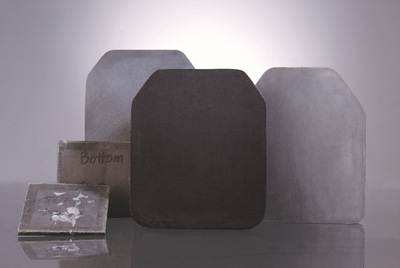玻璃陶瓷也称微晶玻璃或微晶陶瓷,是20世纪50年代初发展起来的新型无机结晶材料,它以较高的机械强度和硬度、良好的化学稳定性等优异性能而著称。更由于这种新型无机材料
不老化变质,长期存放于人体组织内无刺激和不良反应,因而近年来,国内外科学工作者对玻璃陶瓷材料在医学领域中的应用进行了深入研究。
1.玻璃陶瓷的分类
将加有成核剂的(也有不加的)特定组成的基础玻璃在一定温度下热处理后,就得到具有微晶体和玻璃相均匀分布的复合材料,称之为玻璃陶瓷。
玻璃陶瓷的分类按基础玻璃组成可分为硅酸盐、铝硅酸盐、硼硅酸盐、硼酸盐及磷酸盐五大类。

2.玻璃陶瓷的生产工艺
玻璃陶瓷的生产工艺过程随产品的种类不同,具体的工艺制度也各有特点,其基本的工艺过程大致如下:
配合料制备→玻璃熔融→成型→加工→结晶化处理→再加工玻璃陶瓷的生产关键在晶化处理阶段:第一阶段为成核阶段,第二阶段为生长阶段,这两个阶段有密切的联系。在第一阶段必须充分成核,在第二阶段控制晶核的生长。
玻璃陶瓷的析晶过程由3个因素决定:①晶核形成速率;②晶体生长速率;③玻璃的粘度。这3个因素都与温度有关。
玻璃陶瓷的结晶速度不宜过小,也不宜过大,有利于对析晶过程进行控制。
为了促进成核,一般要加入成核剂。一种成核剂为贵金属,如金、银、铂等离子,但价格较贵;另一种是曾通的成核剂,有TiO2、ZrO2、P2O5、V2O5、Cr2O3、MoO3、氧化物、氟化物、硫化物。当然,对生物陶瓷的成核剂选择还应考虑是否有毒性。
3.玻璃陶瓷的结构与性能
玻璃陶瓷是由结晶相和玻璃相组成的,无气孔,不同于玻璃也不同于陶瓷。结晶相是多晶结构,晶体细小,比一般结晶材料要小得多,一般小于1~2μm,晶相含量一般为50%~90%,玻璃相含量一般为5%~50%。玻璃陶瓷中结晶相、玻璃相分布的状态随它们的比例而变化。
玻璃相的比例大时,则玻璃相为连续的基体,而彼此孤立的晶相均匀地分布在其中;如玻璃相的数量较少时,玻璃相分散在晶体网架之间,呈连续网络状;当玻璃相数量很少时,它就以薄膜的状态分布在晶体之间。
玻璃陶瓷的性能,主要由析出晶体的种类、晶粒大小、晶相的多少以及残存玻璃相的种类及数量所决定。而上述诸因素又取决于玻璃的组成及热处理制度。此外,成核剂的使用是否适当,对玻璃的微晶化起着关键的作用。
具有不同主晶相的玻璃陶瓷在其性能方面(如化学稳定性、膨胀系数等)都会有很大的差别。如主晶相为堇青石(2MgO·2Ai2O3·5SiO2)的玻璃陶瓷,具有良好的高频绝缘性能;主晶相为β-石英固溶体的玻璃陶瓷,具有膨胀系数低和较高的透明性能。若要制造有特殊性能要求的玻璃陶瓷时,就必须控制主晶相的种类。
主晶相的晶粒大小对玻璃陶瓷的力学性能、光学性能等都有影响,在一定的尺寸范围内,玻璃陶瓷的强度也与晶粒大小有关。
此外,在玻璃陶瓷中晶相的含量也影响着材料的性质,而且晶相的含量对性质的影响起决定性作用。玻璃的性质和数量对玻璃陶瓷的性质(如机械性质、热学性质)也都有一定的影响。化学稳定性、热稳定性等在一定条件下取决于玻璃相的性质和数量。玻璃相的存在是玻璃陶瓷淬火强化的先决条件。当玻璃相的膨胀系数大于晶相,其数量超过15%~20%时就可以通过淬火使玻璃得到强化。
玻璃陶瓷具有许多优良的性能,如具有较高的机械强度,玻璃陶瓷的机械强度比一般玻璃高很多,抗压强度为0. 59~1. 02GPa,抗弯强度为88. 2~220. 5MPa,抗张强度为49~137.2MPa,特殊的或增强的玻璃陶瓷抗弯强度高达411. 6~548. 6MPa。
玻璃陶瓷的硬度很高,具有突出的耐磨性能。其硬度高于高碳钢、花岗岩,接近淬火工具钢的硬度。其维氏硬度值为5. 9~9. 3GPa。
玻璃陶瓷的弹性模量一般为88~98GPa,泊松比为0. 25~0. 29。
玻璃陶瓷耐强酸、强碱性能高于一般玻璃。例如以β-锂辉石为主晶相的玻璃陶瓷在90℃时与15%HCI作用,经24h后,其侵蚀量为0. 02%~0. 03%。
声明:本文由 CERADIR 先进陶瓷在线平台的入驻企业/个人提供或自网络获取,文章内容仅代表作者本人,不代表本网站及 CERADIR 立场,本站不对文章内容真实性、准确性等负责,尤其不对文中产品有关功能性、效果等提供担保。本站提醒读者,文章仅供学习参考,不构成任何投资及应用建议。如需转载,请联系原作者。如涉及作品内容、版权和其它问题,请与我们联系,我们将在第一时间处理!本站拥有对此声明的最终解释权。













